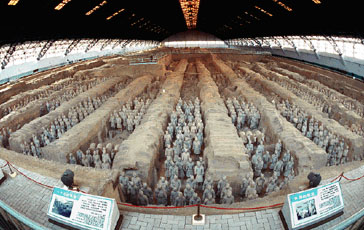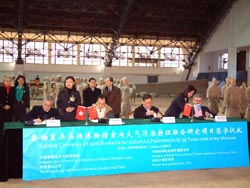

Teaming up with experts from the Emperor Qin's Terra-cotta Museum, the Hong Kong Polytechnic University and the Desert Research Institute of the United States, CAS scientists will make efforts to protect the Museum's terra-cotta warriors and horses from a modern day foe − pollution.
A joint research on indoor air pollution at the Museum has been launched recently in Xi'an, capital of northwest China's Shaanxi Province. Prof. An Zhisheng from the CAS Institute of Earth Environment and Curator of the Museum Wu Yongqi will take charge of the 2-million-yuan (US$ 240,000) project. In the next two years, scientists will carry out research into pollutants' impact on the terra-cotta warriors and horses that once guarded the tomb of Qin Shihuang, China's first emperor in the Qin Dynasty (221BC−206BC).
The terra-cotta warriors and horses were accidentally discovered in Lingtong, a place 40 kilometers outside the Xi'an in 1974, when local farmers drilled wells in search of water. Exploration of the area began that year, with three pits eventually being excavated. The Emperor Qin's Mausoleum was put on the list of the UNESCO as a world-class cultural heritage site in 1987. The mausoleum has been developed into the largest on-site museum in China.
The Museum receives more than 1.5 million visitors each year over the past more than 25 years . Due to a combination of general air pollution, raised temperatures and humidity in the mausoleum and pollution from tourists visiting the museum, the terra-cotta warriors are being affected, showing signs of suffering from mold.
In a bid to make clear the changing patterns and mechanism of chemical reactions occurring in the air, involving corrosive gases (SO2 and NOx), atmospheric aerosol (acidic, mineral, and carbon) and dust in the museum, the scientists will carry out a joint observation and continuous monitoring from March 2005 to February 2007. They will try to reveal the damaging mechanism caused by the pollutants on ancient artifacts in an all-round way and work out scientific approach to effectively protect the terra-cotta figurines.
Experts say that the project could offer fundamental materials to the protection of cultural relics, becoming a precursory model in prevention of air pollution at Chinese museums throughout the country. With the implementation of the research project, the State museum administration plans to develop a task force and a research lab for the studies into environmental setting of historical site and set up a databank on indoor micro-climate, corrosive gases, aerosol and fall-out dust.








